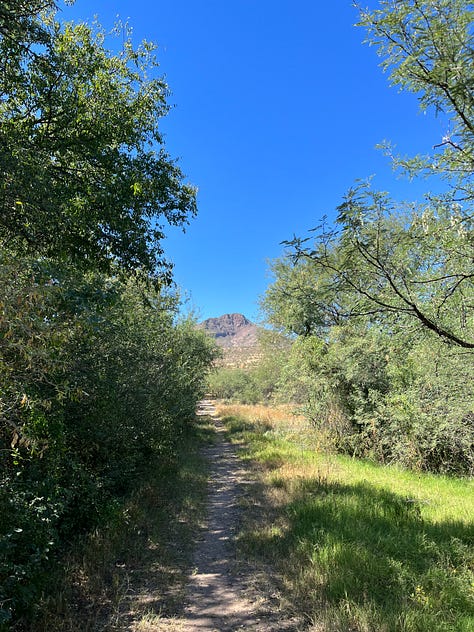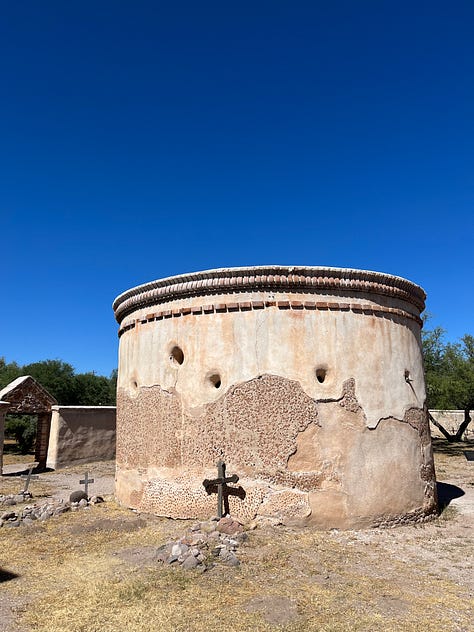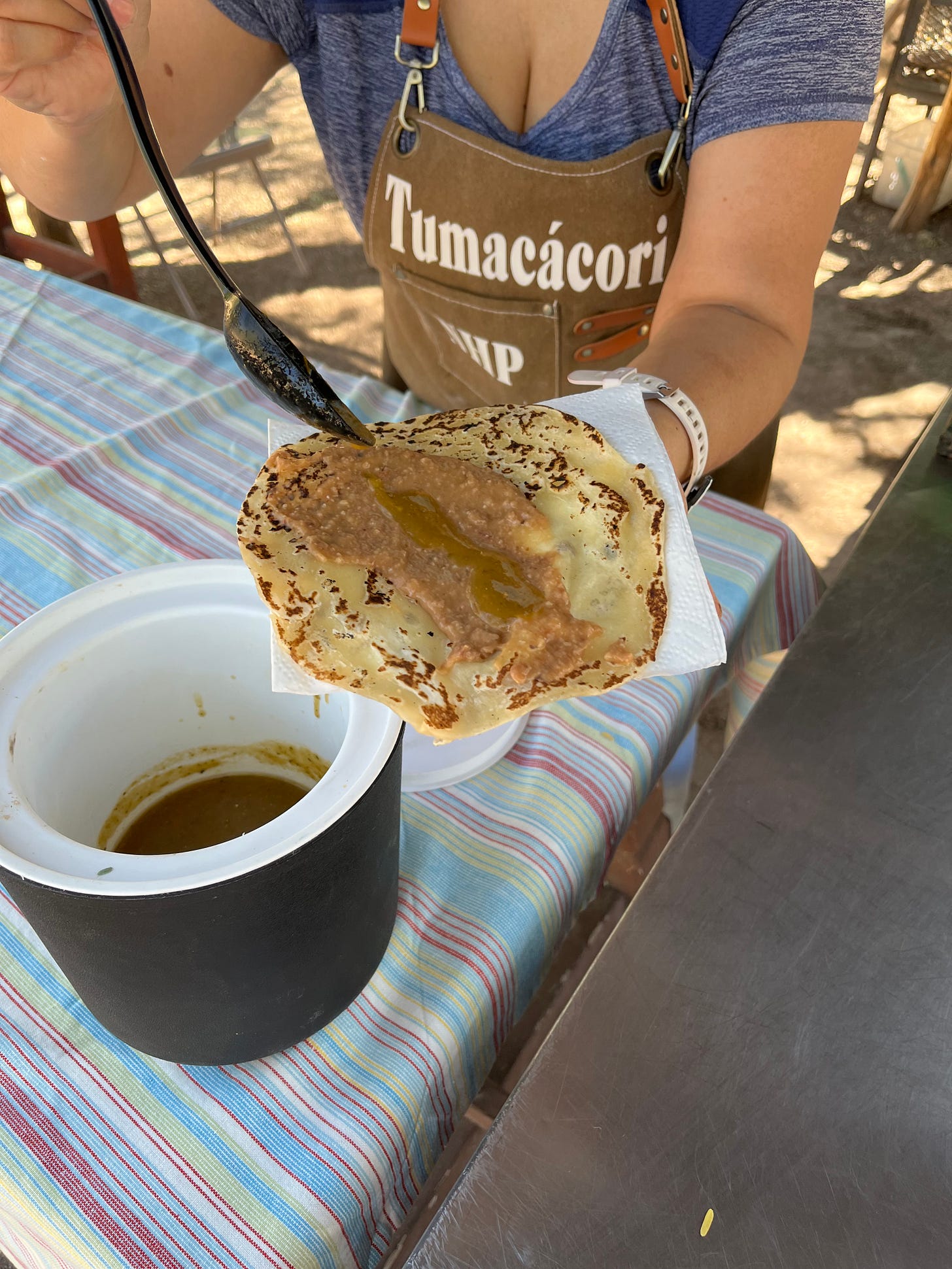Revenge of the Colonized
In the borderlands, the wheat flour tortilla is a subversion of empire.
“When Europeans came to the new world, they learned nothing on the way, as if they came through a dark tunnel. Plymouth, Lisbon, Amsterdam, then the rolling Atlantic for three months, then the rocks and pines, sand and palms of Cathay, the Indies, the wilderness.” –Guy Davenport, The Geography of the ImaginationA dozen miles south of downtown Tucson on Interstate 19 the highway signs turn metric, a reminder of our closeness to Mexico, and even the Waze bot, normally so comfortable with conceptions of miles and feet, now gives alerts in kilometers. Here in the borderlands, the air itself stretches or shrinks in a process of recalibration without judgment: the border is what it is, neither open nor shut, dangerous nor benign, but liminal.
Just south of Tubac, at Tumacácori1 National Historical Park, the air is luscious: bright and clear, 32 degrees or 90, soft and still, as if the in-between status of this spot 20 minutes from ports of entry in Nogales gives it a suspendedness it’s possible to feel on your skin. The park preserves the Mission San José de Tumacácori across hundreds of acres of desert scrubland, bosques (small forests) of graceful spreading black-bark mesquite trees, and a stretch of the Santa Cruz River, dry this time of year, a damp, cracked runner scrolling through delicate, airy undergrowth and shady cottonwoods. We walk around the site, referring to the laminated loaner booklet a park ranger gave us at reception. Here’s the roofless storehouse where grains and seeds were kept in clay jars; here the dry stone cistern, once filled from the diverted Santa Cruz, where women washed clothes; here the graveyard where nobody’s buried anymore, a handful of rock-piled dummy burial mounds arranged around the circular roofless chapel.
Spanish Jesuits established the first missions around here in 1691. (The mission project began 50 years earlier, in present-day Fronteras, Mexico, 150 miles to the east and south.) Jesuit settlements formed the front line of Spain’s colonial offensive in what it named Pimería Alta, Upper Pima Lands, extending from the modern State of Sonora in Mexico into Arizona—a huge swath of Sonoran Desert. At the time Spain claimed possession, it had been home for thousands of years to the O’odham people. New Spain wanted silver and needed people to work in the mines; wanted riches from wheat and livestock and needed agricultural and ranching labor. The colonials converted (persuaded or compelled) the migratory O’odham into settled growers of wheat: pale, yellowish grains brought from southern Spain, though the precise variety is a mystery.
Honestly the history of this place is confusing—how the first mission was abandoned and rebuilt here, passed from Jesuits to Franciscans; how it thrived in colonial terms, becoming the center of local agricultural production; how it was abandoned; fell into ruin, was looted and stripped. How the church was restored in the early 20th century to look like Civil War–era photos of the already dilapidated structure, part of a tower and the roof missing. Honestly the history of the borderlands is confusing: a story of annexation and neglect; of indigenous punishment and conversion; the pain, coercion, and death that made this settlement possible, a history our laminated book doesn’t mention.



“Tumacácori sits at a cultural crossroads in the Santa Cruz River valley,” the Park Service literature says. “Here O’odham, Yaqui, and Apache people met and mingled with European Jesuit and Franciscan missionaries, settlers, and soldiers, sometimes in conflict and sometimes in cooperation. Follow the timeworn paths and discover stories that connect us to enduring relationships, vibrant cultures, and traditions of long ago.”
It all sounds so casual and accidental, that Sometimes in conflict and sometimes in cooperation, like the ups and downs of a marriage, the conflict or cooperation on any given day dependent on somebody’s mood. “Enduring relationships” indeed. You sense a hundred-year-old project—no doubt dating to the years after Arizona became the 48th state of the Union, in 1912—to revise the meaning of the colonial project. Part of Tumacácori’s fruit orchards have been restored, thanks to volunteers and the University of Arizona, planted with Mediterranean specimens the Jesuits would have known: fig and apricot; pomegranate, quince, and peach—a taste of Eden in the devil’s scrubland, where the Western Diamondback probes the air with its tongue to identify the weak and vulnerable. Missing is any mention of older indigenous traditions: the harvesting of fruit from saguaros, prickly pears, and chollas. There’s an unspoken thesis here, that the Europeanization of the border borne on the flesh of fruit, wheat, and livestock was a huge step forward in the arc of a history cast as inexorable and optimistic, the dogged linearity of progress.
There’s the Baroque assertion of power this mission represents, this garish flooding of the desert with flesh and sweetness, aromatic spices and intoxicating drinks, all the status consummables of 17th and 18th century Spain. Put cynically, indigenous conversion was at the center of a vast European wealth initiative. New Spain calibrated a complicated caste system with a touchstone of Spanish, i.e. white, purity. Food reinforced this ranking; served as one of its material cues. So wheat was not merely a way to root previously migratory people; keep them enslaved to the rhythm of plowing, planting, and harvest. Wheat meant bread, which set pure Spanish apart from the crude, corn-eating Indians and creoles of every degree. Wheat meant the Eucharist.
There’s a modern replica of an 18th-century Communion sheet in the Tumacácori museum: a pale sheet of unleavened bread stamped with a large Baroque cross in the center and smaller ones at the corners, presumably meant to be broken into individual Hosts during Mass. Through Consecration it would become the actual flesh of Jesus: the original lab meat, I guess, where the transformation lab is the complicated project of hauling wheat to a world cast as new, forcing its converted souls to grow it; to embrace it. The borderlands are a messy, brutal factory of change, grinding out revisions to history and culture.
“Missionaries and settlers wrote with great pride about their success in planting wheat throughout the north,” historian Jeffrey M. Pilcher writes in Planet Taco: A Global History of Mexican Food. “They considered golden fields of the grain to be a sign of civilization on the savage frontier.”
According to Pilcher, in 1760, after the Bishop of Durango toured the northern frontier, an indigenous man, Agustín Guichi, staged a mock reenactment of the bishop’s visit. He fashioned a cape and a mitered hat, and for three days blessed the locals, distributing pieces of what flour tortilla as fake Communion Host. On the fourth day, Guichi was mauled by a bear in a cornfield and later died after confessing his sins. The mocked bishop broadcast this story as a sign of what happens when you fuck with the church. Could it be, though, that Guichi, besides taking the piss out of the missionaries, was also making a point about communal sustenance? That the flour tortilla had become the source of shared life? Subverting the form of Spanish power to perform a native ritual of adaptation?
Outside the museum, in the mesquite shade between the approach to the rebuilt ruin of a church and the educational garden, a woman is cooking. She’s seen us coming; she’s stretching a pale ball of dough by hand into a tortilla, using gravity, tugging gently. She drops it onto a comal fired with mesquite branches; the smoke fills the still, hot air with a resiny scent. She flips it, cradles it in a napkin while ladling on beans so thin they act as sauce; dabs it with salsa, folds the edges slightly and presents it. You get this with the price of entry to the park, this little snack, a Sonoran merging of taco and burro: stretchy, hot, savory; Spanish grain cooked with fire from the harvest of desert trees, tinged with smoke from the burning of the native bosque. This is the survivor of colonialism’s original sin in this boundless desert, the importation of wheat that defined the border between Euro, indigenous, and the intermarriage of those and more further south in Mexico—wheat flour used in place of nixtamalized corn as sustaining food: the anti-bread. The essence of the borderlands.
Tooma-COCK-oree




Absolutely a necessary reading today
This is a beautiful piece of writing.